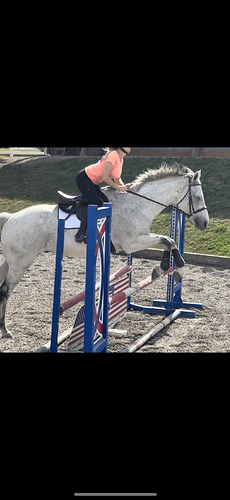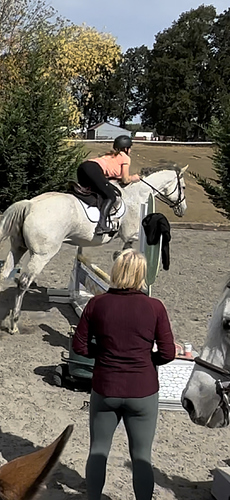I am leasing a new horse. My last horse had a higher head carriage and a flat jump and it seemed easier to not over fold and sit up tall over small jumps. I know I need to work on my leg strength and it’s a little slipped back and heels need to be down more but how can I convince myself to not fold so much. It looks horrible like in my mind I think I’m jumping a 1.5 meter jump. I can’t help but think I look like a Swiss Army knife folding lol 
From your description, I was expecting something more dramatic, honestly!
Often the urge to overjump for the horse is related to planting the hands on the neck and trying to “release” with the upper body instead. The chin juts out, upper body goes forward, the leg slides back, all pivoting around the hands.
If you can get your hands and body independent from each other, it’ll help. Can you try some gymnastics with no hands/one hand?
ETA: you can also try “showing the bottom of your boots to the fence” as a way to get those heels under you and your base more stable. Think about sinking extra weight into your heels the last two strides and over the fence. That + a more independent hand + core strength = stability!
What happens in your upper body has everything to do with what’s happening in your lower body. You’re most likely folding forward in anticipation of a bigger jump that might leave you behind. To not get left behind, you’ll want to - just as you said - get that heel down and underneath you to give you a stable base of support. Core strength, especially in your lower abdomen, will also help you keep yourself upright as your horse pushes off.
And hey, it doesn’t look horrible. We’re all learning and improving, all the time - it’s hard!
@fivestrideline has great suggestions
I would also recommend the 1 hand item (that way you don’t have to just do this in a grid, but also on course) - bridge reins in outside hand - inside hand / arm points straight forward fully extended so hand, elbow shoulder are pointing to the ears. Jump fence, rinse repeat.
I’d have to dig deep in my photos to find one of myself doing this exercise. Old trainer made me do this all up to .90cm
Double post - wait there is a pun here 
To get your leg stable and under you - Double post at the trot. Where you stay rising for 2 beats then sit for 1 beat, repeat. Ask your trainer before you do it - do not recommend practicing this on a very sensitive or KS horse.
That will begin your work to get your leg independent and underneath you and have you engage your core to stabilize yourself.
I can’t be certain based on these photos, but have you ever been evaluated for an anterior pelvic tilt? Its rather common in students and people who sit at a desk for a living. Tight hip flexors, elongated hamstrings and you end up with that lower back curve. If you have that lower back curve going to the jump your pelvis is still leaning forward even if your shoulders are back, and then you are going to want to throw yourself forward to “catch up.” Try doing some hip flexor stretches, tightening the core, and strengthening your hamstrings.
I noticed that too. Some hunter programs actually encourage perching like this with your butt in the air and your back swayed. But it’s not the most secure jumper position. It might be something that’s more “natural” for junior girls who don’t have a lot of upper body strength yet, a weakness made into an aesthetic norm in junior competition.
Been thinking about this while at work so I’ll add another thought:
You know the old “let the horse jump up to you” phrase? That one makes no sense to me, personally. It’s just not a feeling I have ever understood.
What I HAVE felt is this: Basically instead of Jumping The Jump, think of sinking down and pressing all you weight into your stirrups/heels while in the air. The last two strides, in the air, and landing, put all your focus into pressing into your base and pushing away from the horse’s neck. The Press Away works best with a (reasonable) long release. The feeling is almost like sinking down into the jump vs jumping for the horse. Seems to work for me, and might help 
Lots of good advice. I also like setting up a chute with a series of bounce jumps, low like 18”. Once horse is working smoothly through, knot your reins and see if you can do the chute with one hand, then no hands.
I find the bounce jumps are actually easier to ride without reins than just one jump because the horse isn’t looking to change striding or turn, is less likely to overjump, so it’s pure balance and rhythm so you can get the feeling of where your body is in each stage of the jump.
For extra fun, close your eyes 
I love this! Yes I think a new visualization will be very helpful.
This is a great idea! I do Rene be doing this in lessons before. Thanks.
Hard to tell from a still photo but you appear to be standing up on your toes in your stirrups and balancing your upper body with knuckles in his neck. Pretty common. You are working way too hard to get the horse over the jump instead of relaxing and going with him.
Used to do that myself. Would have you work without irons for at least a few minutes every ride…don’t have to kill yourself just drop the irons for a lap or two, even just at the walk it will help you strengthen your lower body. The more you can do this, the better you will get
The second very old, traditional fix for this is the old helicopter arms and/or one hand on helmet. Its exactly what it sounds like, one arm straight out to the side, then the other, then both. Or you can put one hand on the top of your helmet, then switch to the other then eventually go to both hands on the helmet. Start at the walk. Over time you go to the trot, then canter…eventually over poles then low fences. Takes time to master it. Helps to have a kind horse too.
Do you have to ride only in lessons or do you get to practice on your own? Of course you should talk with your trainer about this, maybe she’s willing to incorporate these time tested exercises into her lesson plans?
Thank you so much everyone for your help. Just hearing things a diff way helps. Here’s a tiny clip of my last lesson. I feel like I look a little teeter tottery. I’ll keep working on up, up, downs, no stirrups, one hand out etc.
IMG_8122
Shorten your stirrups a hole or two. Move the stirrup bar forward to the ball of your foot


